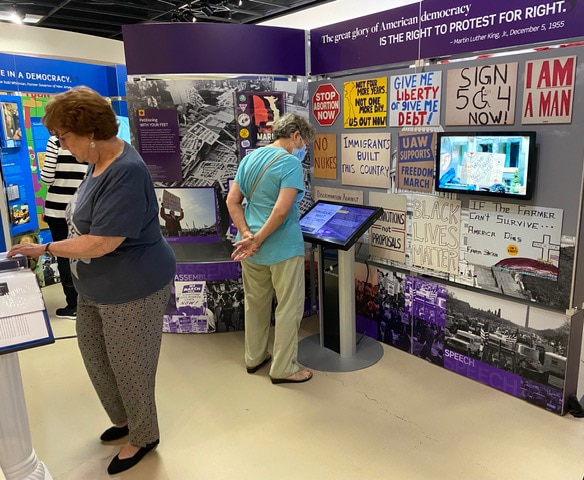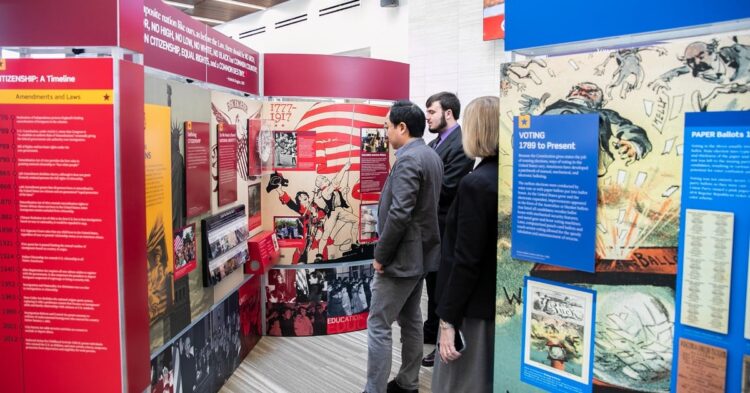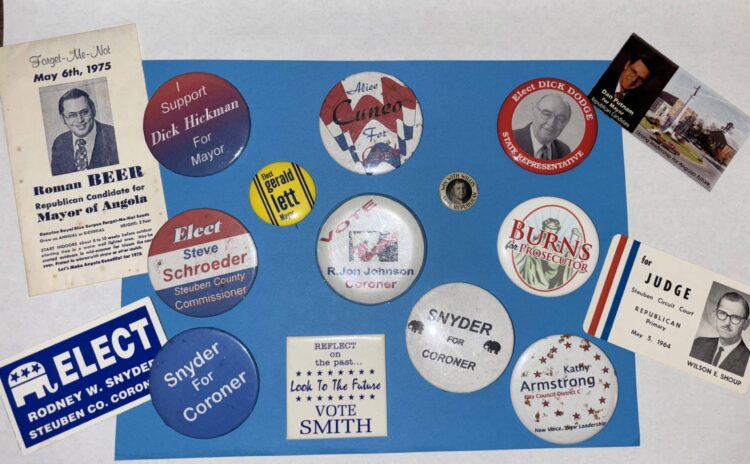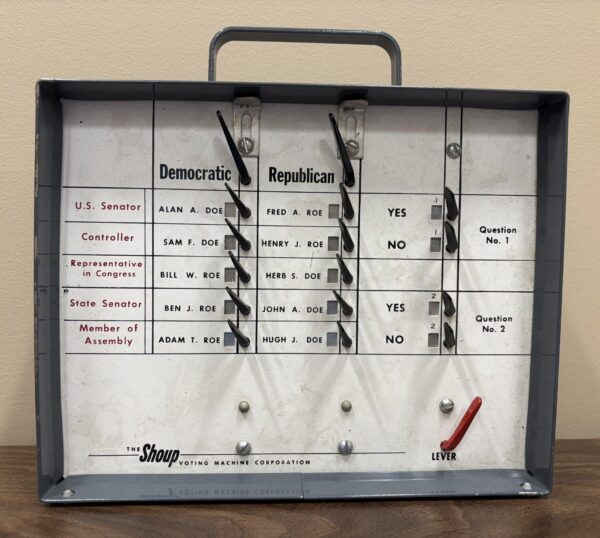
By Dwight Adams
The Indiana Citizen
August 15, 2025
Have you ever considered why some of Indiana’s earliest settlers were abolitionist Quakers, or wondered how a voting machine looked a century ago, or were curious what famous Hoosier presidential candidate Wendell Willkie was like?
You will soon be able to immerse yourself in local history and more when the Smithsonian Institution exhibition, “Voices and Votes: Democracy in America,” arrives in Indiana next year. The traveling exhibit will visit seven small Hoosier towns and cities starting in 2026, which coincides with the 250th anniversary of the signing of the Declaration of Independence.
“We’re excited to create a mix of ways to engage with this history as the 250th anniversary approaches,” said Megan Telligman, director of programs at Indiana Humanities, which applied to participate in the “Voices and Votes” program when it launched five years ago.
“The exhibit will land at a really important time,” Telligman said. “The bicentennial saw a flourishing of interest in our history … and I’m very hopeful that hosting this event in 2026 will generate a lot of interest in historical knowledge and institutions that help promote that knowledge. We wanted to make sure that we had something big and important to bring around the state and the Smithsonian was perfect for that.”
Indiana Humanities, in partnership with Museum on Main Street, selected the following communities to host the exhibition for about six weeks each in either 2026 or 2027:
“Voices and Votes” is part of the Smithsonian’s Museum on Main Street program, which brings traveling exhibitions, educational resources and programming to small, rural communities across the country.
Since Indiana will be the last state to host “Voices and Votes,” Telligman said the Smithsonian is allowing the state to stage the exhibition for a little longer before it must be returned to the Washington, D.C.-based museum. The extra time has allowed Indiana Humanities to add a seventh host community and extend the number of days it will be open at each site.
Telligman said they tried to strategically choose the host communities based on geography to ensure that an exhibition site was within an hour-and-half’s drive for any resident of the state.
This year, the host communities will receive extensive training and other resources for free from the Smithsonian and Indiana Humanities to help them create and stage the exhibit.
The exhibit will feature walk-through displays of historical and contemporary photos with accompanying text, educational and archival video, multimedia interactive displays with short games, and displays of historical objects, including protest signs, political campaign souvenirs and voter memorabilia.
The traveling exhibit is based on a major exhibition at the Smithsonian’s National Museum of American History developed by curator Harry Rubenstein and designed to prompt visitors to explore topics related to democracy and our American government, such as “Who has the right to vote?”, “What are the freedoms and responsibilities of citizens?”, “Whose voices will be heard?”, “How do you participate as a citizen?”, and “How do we encourage more people to participate in our democracy?”

The Smithsonian created four, “very similar” copies of the exhibit to tour the country, so that it could be held in four states at a time each year, Terri Cobb, registrar with the Smithsonian’s Museum on Main Street initiative, said. Launched in March of 2020, “Voices and Votes” will have visited 28 states when it finishes its run in 2027. The content the Smithsonian provides for the exhibit is “fairly general,” so that it can be applicable in towns across America, she said.
“One whole section of the exhibition is about how we gain the right to vote and what it takes to keep or retain that right,” Cobb said. “It talks about how people were enfranchised and disenfranchised throughout history.”
The Smithsonian also requires the host communities to develop their own specialized content to tell their own local stories about democracy and efforts at civic engagement, “so visitors can come in and see themselves through those stories,” Cobb said.
Cobb said each site also will have a touch-screen, oral history kiosk that will include video interviews with local civic leaders of other communities who have hosted “Voices and Votes” to gauge their thoughts about democracy and will include the option of having the new host community’s leaders add their voices to the video, too.
Cobb said learning about democracy and civics will become even more important next year during the semiquincentennial.
“I think they are important topics at all times, but I hope that our visitors from Indiana and around the nation will be exploring these themes, their rights, and the mechanics of democracy, (such as) what it means to participate and how do you participate – through petitions, through voting, through participating in the census, although that won’t be available next year, and other ways,” she said. “I think that’s vitally important, especially as we explore our 250th next year.”
Some of the host communities in Indiana are planning events to celebrate the 250th anniversary, many of which will complement the “Voices and Votes” exhibition.
Joe Lannan, executive director of the Visit French Lick West Baden tourism organization, said they have planned programming in each of their townships and communities over the next year and have earmarked the “Voices and Votes” exhibit as the “culmination of the celebration leading up to the July 4th holiday.”
Lannan also said the exhibition coordinates well with the semiquincentennial in 2026 and added that they recently launched the celebration in their county by dedicating a new flagpole that was topped just for the event by a large flag that had once flown over the U.S. Capitol.

Allison Daglow, community coordinator for the city of Angola, said they’re brainstorming ideas to help celebrate that 250th anniversary, such as showing films from the past at the local movie house or having a local coffeehouse feature a patriotic drink.
“We’re still in the works with some of those plans, but our hope is that we really have a big celebration, especially when the exhibit is in our community,” Daglow said.
And in Rushville, Parks Director Kathi Jackley, who is helping coordinate the “Voices and Votes” exhibit there, said that city’s local historical society has already begun planning local events to celebrate the semiquincentennial and she hopes to coordinate with them regarding some of her activities surrounding the exhibition when it arrives in her city.
Indiana Humanities receives funding from individuals, corporations, foundations and governmental sources to support its community programs. But it also raises funds locally to support those initiatives.
That need for donations is especially acute this year. Even though the nonprofit was appropriated $1.3 million by Congress for fiscal 2025 to support its operations, trainings and grants, the organization has only received $500,000 of that amount, Telligman said, meaning that they must gain more support from local and national foundations, as well as individual donations, to close that gap.
While some fees have already been paid to reserve the “Voices and Votes” exhibit, Telligman said funding the exhibit also could be more of a challenge going forward. Specifically, they will need to raise an additional $23,000 to cover costs for the exhibit that would have been supported by federal funding.
“As you know, the federal funding that has supported Indiana Humanities for the past 53 years was terminated in April and has not been reinstated at the Congressionally-approved level for this fiscal year,” Telligman said in an email response to questions from The Indiana Citizen.
“Typically, this federal funding would have supported trainings and grants to host organizations for development of local programs and exhibitions,” she added. “While we have reallocated funding to support some of these costs, we are still actively seeking sponsors to support promotional efforts, training opportunities, and shipping fees to move the exhibition from site to site.”
Jackley said she is excited about telling the story of the 1940 Republican presidential campaign of Willkie, a native Hoosier who lived for a time in Rushville while he ran for the highest office in the land. His Rushville home was added to the National Register of Historic Places in 1993.
While the Love Community Center on North Main Street will be the main site of the exhibition, Jackley said she hopes to stage a display of Willkie’s campaign buttons at a park in downtown Rushville called Willkie Park, named after him. She also said they hope to stage an art exhibition at the Booker T. Washington School, which will feature local artworks addressing the themes of democracy and America.
Jackley said the exhibit will help Hoosiers become more civically engaged at a time when many people are “disconnected about how government really works.” Even the “simple act” of knowing the candidates and the issues and then going to vote is something fewer and fewer people are doing, she noted.
“Already, just having small conversations with people in the community, trying to learn about other people’s experiences about democracy, what does it mean (to them) is important. … What are their stories?” Jackley said. “That is something that we hope to bring forward.”
Daglow said the exhibit will be staged at the local Carnegie Library in Angola, which is within walking distance of Trine University and should attract some students from there. She also hopes it draws people from Michigan and Ohio, and maybe even the Chicago area.
“We are excited to be a part of it,” Daglow said. “Some of the things that we’re going to showcase are some local artifacts, so we’re hoping our exhibit will be more visual and hands-on. We’re trying to make the exhibit interesting, really heavily focused on our history but also interactive for the public.”

Some of those local features, she said, will include displaying a replica of an old Shoup voting machine that is on loan from the local courthouse and would have been the type used in Steuben County in the early 1900s. A large collection of local political pins and buttons owned by a local resident also will be featured and Daglow said “it’s neat to see what some of the slogans were over the years.”
Lannan said his community in southern Indiana has a “rich history of civic engagement” that they plan to highlight, including the history of Orange County, Indiana’s settlement by abolitionist Quakers, the area’s hosting of the 1931 Governor’s Conference and the preservation of historic properties owned by the area’s civic and political elite. The main “Voices and Votes” exhibit will be housed in the French Lick West Baden Visitors Center, which occupies the ground floor of the historic Oxford Hotel, built in 1913, in West Baden Springs.
The local component of the exhibit also will include presentations from the local high school’s advanced history class, Lannan said. School field trips to next year’s exhibition in his community are already being planned and a moderated panel on civic leadership will be held to complement the exhibit.
He’s also talking to local election officials about possibly having a kiosk at the exhibit where people can check their current voter registration status and maybe even be able to register. He hopes that hosting “Voices and Votes” will not only provide an economic lift to the area, but will also serve as a hub for civic thought and dialogue.
“I imagine that most Hoosiers know the broad strokes – or at least the daily news soundbite – of the U.S. government but less about how local decisions are made,” he said in an email response to questions from The Citizen. “By tying national themes and civic functions to familiar hometown stories, the exhibit should make concepts like voting rights, public meetings and petition drives tangible.”
Daglow, the Angola community coordinator, said they’re considering displaying a map of the voting locations in Steuben County at their exhibit.
She said the “Voices and Votes” exhibition will help Hoosiers “be more informed and more educated,” regardless of their age and how much they already know about our government and history.
“But the main focus of this exhibit will be our youth, to teach them about our government and our history,” she said. “I think the generation coming up craves knowledge and I think that’s what our exhibit aims to do. Really, the idea is to educate the public about the importance of voting and that your voice makes a difference.”
Dwight Adams, a freelance editor and writer based in Indianapolis, wrote this article. He is a former content editor, copy editor and digital producer at The Indianapolis Star and IndyStar.com, and worked as a planner for other newspapers, including the Louisville Courier Journal.
The Indiana Citizen is a nonpartisan, nonprofit platform dedicated to increasing the number of informed and engaged Hoosier citizens. We are operated by the Indiana Citizen Education Foundation, Inc., a 501(c)(3) public charity. For questions about the story, contact Marilyn Odendahl at marilyn.odendahl@indianacitizen.org.